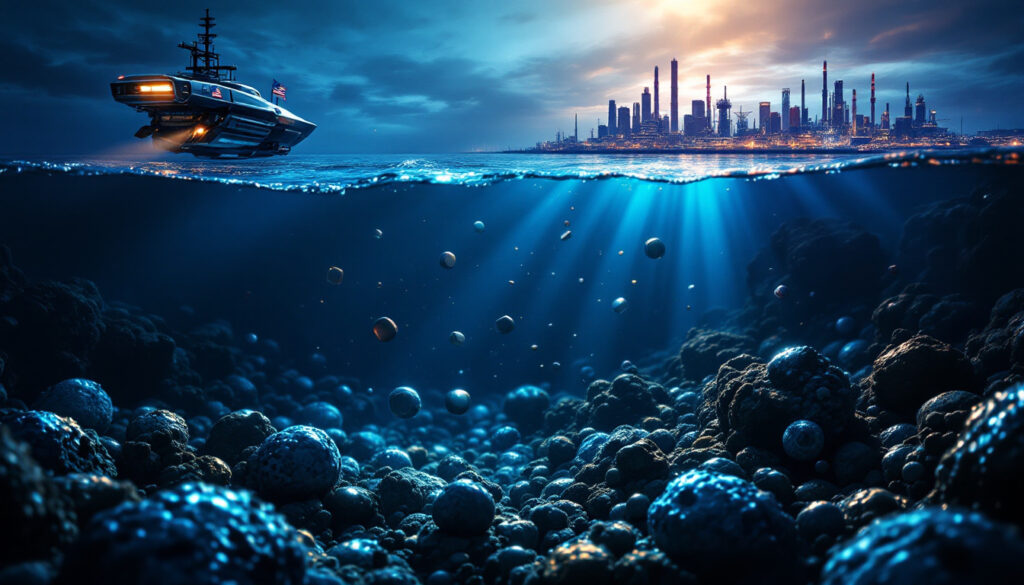What Is the Executive Order on Critical Minerals Stockpiling?
Overview of Trump's Executive Order
President Trump's 2025 executive order represents a bold shift in U.S. mineral security strategy, authorizing the stockpiling of critical minerals harvested from polymetallic nodules on the Pacific Ocean seabed. This unprecedented initiative focuses primarily on securing battery metals and rare earth elements essential for America's technological and defense infrastructure. The order effectively creates a regulatory fast-track for deep-sea mining companies like The Metals Company to begin extraction operations under U.S. law, bypassing lengthy international approval processes.
With growing concerns about China's dominance in critical mineral supply chains, the order establishes a framework for building strategic reserves of minerals that power everything from electric vehicles to advanced weapons systems. Industry analysts note this could unlock access to trillions of dollars worth of minerals currently sitting untouched on the ocean floor.
Strategic Objectives and National Security Implications
The executive order builds upon the previous activation of the Defense Production Act for critical minerals, but significantly expands the scope to include ocean resources. At its core, the initiative aims to reduce the alarming U.S. dependency on foreign mineral supplies—particularly from China, which controls over 80% of global rare earth processing capacity.
"Control of these minerals represents control of the technologies of tomorrow," stated Defense Secretary James Williams when discussing the order's implications. "Without secure supply chains, our military readiness and technological leadership are at risk."
By designating seabed minerals as vital to national security, the administration has positioned this stockpiling effort as essential to maintaining U.S. technological superiority in fields ranging from renewable energy to quantum computing and hypersonic weapons development.
Why Are Critical Minerals Important to the US Economy?
Critical Applications in Modern Technology
The minerals targeted in this executive order to stockpile critical minerals form the backbone of modern technological infrastructure. Cobalt and nickel are essential components in lithium-ion batteries, with a single electric vehicle requiring up to 20 pounds of these metals. Rare earth elements like neodymium and dysprosium are crucial for the powerful permanent magnets used in wind turbines, where a single 3-megawatt turbine can contain nearly 2 tons of these materials.
Beyond clean energy, these minerals enable advanced defense systems like night vision goggles, precision-guided munitions, and radar technologies. The F-35 fighter jet, for instance, contains approximately 920 pounds of rare earth elements, highlighting the direct connection between mineral security and military capability.
Communications infrastructure, from fiber optic cables to 5G networks, relies heavily on elements like gallium and germanium. Meanwhile, medical devices such as MRI machines cannot function without superconducting magnets containing rare earth elements.
Economic Significance and Supply Chain Vulnerabilities
America's current dependence on foreign mineral sources creates substantial economic vulnerabilities. The U.S. Geological Survey reports that America is 100% import-dependent for 14 critical minerals and more than 50% dependent for another 17. This import reliance creates a calculated $5.8 billion annual vulnerability to supply disruptions.
Supply chain experts note that even temporary disruptions can have cascading effects through manufacturing sectors representing over $3 trillion in annual economic output. During recent supply shortages, the price of neodymium magnets increased by 750%, demonstrating the volatility that threatens downstream industries.
Industry projections suggest that domestic production of these minerals could generate approximately 24,000 direct jobs and 75,000 indirect jobs, particularly in coastal regions positioned to support deep-sea mining operations and processing facilities.
How Does Deep-Sea Mining Factor Into the US Mineral Strategy?
Polymetallic Nodules: The Untapped Resource
Scattered across vast areas of the deep ocean floor lie polymetallic nodules—potato-sized rock concretions that have formed over millions of years, concentrating valuable minerals at grades often significantly higher than terrestrial deposits. These nodules contain nickel (1.1-1.5%), copper (0.9-1.3%), cobalt (0.2-0.25%), and manganese (25-30%) in a single ore body, allowing for more efficient extraction compared to conventional mining.
The Clarion-Clipperton Zone (CCZ) in the Pacific Ocean alone contains an estimated 21 billion tons of these nodules, with mineral content potentially worth $16 trillion. Geological surveys indicate that a single square kilometer of seabed in prime areas can yield resources equivalent to dozens of terrestrial mines, offering a concentration of minerals unmatched by land-based sources.
Unlike terrestrial mining, which often requires removing substantial overburden and processing low-grade ores, nodules can be collected from the seabed surface with specialized equipment that minimizes disturbance to the underlying substrate. This presents both efficiency advantages and environmental considerations unique to ocean-based extraction.
The Role of Companies Like The Metals Company
The Metals Company (TMC), formerly DeepGreen Metals, stands to benefit significantly from the executive order. TMC holds exploration rights to three of the most promising areas in the CCZ, covering approximately 74,000 square kilometers of seabed with confirmed high-density nodule deposits.
The company has developed a collection system that uses a tracked vehicle to gather nodules from the seafloor at depths of 4,000-5,500 meters. This system, which recently completed pilot testing, can reportedly collect up to 200 tons of nodules per hour while creating minimal sediment disturbance compared to earlier designs.
Under the executive order, TMC and similar companies would operate under U.S. licensing rather than waiting for the International Seabed Authority to finalize its mining code—a process that has been ongoing for over a decade. This regulatory certainty is expected to unlock significant private investment, with analysts projecting up to $7 billion flowing into the sector over the next five years.
How Does This Order Change International Mining Governance?
Bypassing the UN Seabed Authority
The executive order represents a fundamental challenge to the established framework for governing international waters, particularly the role of the International Seabed Authority (ISA). Under the 1982 UN Convention on the Law of the Sea, the ISA holds jurisdiction over mineral resources in areas beyond national jurisdiction, and has been developing regulations for deep-sea mining for over 20 years.
By establishing a U.S.-specific legal pathway for extraction, the order effectively creates a parallel regulatory system outside ISA governance. This approach stems partly from the fact that the U.S. has never ratified the UN Convention on the Law of the Sea, though it has generally observed its provisions as customary international law.
Legal experts note this move creates significant uncertainty regarding ownership rights, environmental standards, and potential conflicts with other nations' claims. The order asserts that companies operating under U.S. licenses will have secure title to resources they extract, but this claim may face challenges in international forums.
Geopolitical Implications and International Reactions
International reactions to the executive order have been swift and divided. Traditional allies like Australia and Japan have expressed cautious support, seeing potential benefits for their own mineral security strategies. In contrast, nations with substantial land-based mining operations, including Chile and Congo, have voiced concerns about potential market disruption.
China, which holds exploration contracts through the ISA system, has condemned the U.S. move as "economic piracy" and threatened countermeasures, including accelerating its own deep-sea mining initiatives. Environmental organizations have organized protests at U.S. embassies in multiple countries, arguing that unilateral action undermines global commodities insights and governance of shared resources.
Diplomatic observers suggest this could trigger a "regulatory race to the bottom," with multiple nations creating permissive frameworks to attract mining companies. Some security analysts predict increased naval deployments to assert claims over promising seabed regions, creating new flashpoints for international tension.
What Critical Minerals Is the US Targeting for Stockpiling?
Key Battery Metals and Their Applications
The executive order prioritizes four key battery metals found in polymetallic nodules. Nickel, which constitutes approximately 20-30% of cathode materials in advanced EV batteries, enables higher energy density and longer range. Current forecasts project a nickel deficit of 100,000 tons by 2030 due to growing EV adoption, making it a priority target for stockpiling.
Cobalt, despite efforts to reduce its use in batteries, remains essential for thermal stability and cycle life in high-performance applications. With 70% of global cobalt production concentrated in the Democratic Republic of Congo, supply risks from political instability and ethical concerns about mining practices make it strategically important.
Copper serves as the fundamental conductor in electrical systems, with EVs requiring 2.5 times more copper than conventional vehicles. The International Energy Agency projects copper demand will double by 2040, driven by electrification and renewable energy infrastructure.
Manganese, often overlooked but critical for both steel production and battery cathodes, contributes to battery chemistry that reduces reliance on cobalt while maintaining performance. High-purity manganese sulfate suitable for batteries currently faces significant supply constraints, with processing concentrated in China.
Rare Earth Elements and Strategic Importance
The seventeen rare earth elements (REEs) represent another critical focus of the stockpiling initiative. Despite their name, most rare earths are relatively abundant in the Earth's crust but rarely concentrated in economically viable deposits. Their unique electronic and magnetic properties make them irreplaceable in many high-tech applications.
Neodymium and praseodymium are essential for manufacturing NdFeB permanent magnets, which offer the highest energy product of any magnetic material and are crucial for miniaturized electronics and efficient motors. A single F-35 fighter jet contains nearly 920 pounds of rare earth materials, primarily in its radar systems, electronic countermeasures, and targeting equipment.
The U.S. currently relies on China for approximately 80% of its rare earth imports, creating a strategic vulnerability that the executive order directly addresses. While seabed nodules contain lower concentrations of rare earths than battery metals, the order includes provisions for processing terrestrial rare earth deposits as part of the broader mineral security strategy.
How Does This Compare to Previous Mineral Security Initiatives?
Previous Defense Production Act Activation
The current executive order represents a significant expansion of previous mineral security efforts. In 2020, President Trump activated Title III of the Defense Production Act to support domestic production of rare earth elements and critical minerals, providing $209 million in funding for processing facilities and supply chain development.
That earlier initiative focused primarily on terrestrial resources, supporting projects like the reopening of the Mountain Pass rare earth mine in California and the development of processing capabilities at facilities in Texas. The current order not only expands the scope to include ocean resources but also dramatically increases the funding available, with initial allocations exceeding $2 billion.
While the earlier DPA activation emphasized public-private partnerships with existing mining companies, the new order creates entirely new regulatory pathways and establishes a comprehensive strategic stockpile management program modeled after the National Petroleum Reserve.
Evolution of US Mineral Security Strategy
The executive order represents the culmination of a strategic shift that began with the 2017 designation of critical minerals as essential to national security. Initial efforts focused on resource mapping and assessment, with the USGS identifying domestic deposits that could potentially reduce import dependence.
By 2019, policy had evolved to include streamlining permitting for land-based mines and providing tax incentives for domestic processing facilities. The 2020-2022 period saw increased emphasis on recycling and substitution research, with federal grants supporting development of technologies to recover critical minerals from electronic waste and industrial byproducts.
The current order represents a quantum leap in both scope and approach, moving beyond incremental improvements to domestic supply chains and embracing ocean resources as a strategic asset. This shift acknowledges the limitations of terrestrial resources within U.S. borders and the growing urgency of securing mineral supplies in an increasingly competitive global environment.
What Are the Environmental Considerations of Deep-Sea Mining?
Potential Environmental Impacts
Deep-sea mining presents a complex environmental equation. Critics point to potential harm to marine ecosystems that remain largely understudied, with only an estimated 20% of deep ocean species documented by science. The primary concerns center around sediment plumes created during nodule collection, which could disperse over wide areas and impact filter-feeding organisms.
Research vessels monitoring test mining have detected sediment plumes extending up to 5 kilometers from collection sites, though concentrations diminish rapidly with distance. The ecological recovery rate for disturbed areas remains uncertain, with limited data from small-scale tests suggesting recolonization by some species within 5-10 years but potentially longer impacts on nodule-dependent organisms.
Noise pollution represents another concern, as collection vehicles and transport systems operate continuously in previously quiet environments. Studies suggest sound from mining operations could travel up to 500 kilometers underwater, potentially affecting deep-diving mammals like sperm whales and beaked whales that rely on echolocation.
Balancing Environmental Protection with Resource Needs
The executive order includes provisions for environmental monitoring and management, requiring companies to implement "best available technology" standards to minimize impacts. This includes requirements for real-time environmental monitoring during operations and establishment of environmental reference zones where no mining will occur.
Proponents argue that seabed mining may actually have a smaller environmental footprint than equivalent terrestrial mining when considering the full lifecycle impact. Land-based mining typically involves deforestation, overburden removal, acid mine drainage, and tailings storage, issues largely absent from nodule collection.
A lifecycle assessment commissioned by The Metals Company claims that sourcing metals from nodules produces 90% less CO2, 94% less stored carbon at risk, and 93% less wildlife at risk compared to land-based sources. These figures remain contested by environmental groups, who argue that deep-sea ecosystems provide critical carbon sequestration services that could be disrupted by mining.
How Might This Impact US-China Relations?
Escalating Tensions Over Critical Minerals
The executive order explicitly positions critical minerals as a arena of strategic competition with China, which currently dominates global processing capacity for many key elements. By accelerating domestic access to seabed resources, the U.S. aims to counter China's "Made in China 2025" initiative, which identifies control of critical mineral supply chains as a strategic priority.
China has responded by accelerating its own deep-sea mining program, with state media announcing increased funding for the research vessel Dayang Yihao and associated submersible technologies. Chinese officials have also hinted at potential export restrictions on processed rare earths in response to U.S. actions, echoing similar measures taken during previous trade disputes.
Mineral security experts note that this competition extends beyond direct access to raw materials, encompassing processing technologies, refining capacity, and recycling infrastructure. While the U.S. focuses on securing nodule resources, China continues to strengthen its position in mineral processing, creating a complex competitive landscape.
Implications for Global Mineral Markets
The entry of U.S.-backed companies into deep-sea mining could significantly reshape global mineral markets over the next decade. Economic models suggest that full-scale nodule harvesting could eventually supply up to 40% of global cobalt demand and 20% of nickel demand, potentially reducing prices by 15-25% from current levels.
Such price effects would benefit downstream industries in the U.S., particularly electric vehicle manufacturers and renewable energy producers, while potentially undermining the economics of some terrestrial mining operations. Countries heavily dependent on mineral exports, such as Indonesia (nickel) and the Democratic Republic of Congo (cobalt), could face significant economic pressures.
Financial analysts project that companies controlling seabed resources could achieve production costs in the lowest quartile globally, creating durable competitive advantages. This economic reality may drive other nations to develop similar regulatory frameworks, accelerating the transition toward ocean-based mineral sources despite environmental uncertainties.
FAQ About the Critical Minerals Executive Order
What specific minerals are considered "critical" under this executive order?
The order focuses on 35 minerals designated as critical to economic and national security, with particular emphasis on battery metals (nickel, cobalt, copper, manganese) and rare earth elements. These materials are essential for electric vehicles, renewable energy systems, advanced electronics, and defense technologies.
The designation as "critical" reflects both economic importance and supply risk, considering factors like import dependence, concentration of production in geopolitically sensitive regions, and increasing demand projections. While some minerals like lithium have terrestrial sources in the U.S., many others, including cobalt and most rare earths, face significant supply constraints from domestic sources.
How soon could deep-sea mining operations begin under this order?
With the regulatory fast-track established by the executive order to stockpile critical minerals, companies could potentially begin commercial-scale harvesting operations within 3-5 years. The Metals Company has already completed pilot collection systems testing and expects to finalize its environmental impact assessment within 18 months.
The timeline for full-scale operations depends on several factors, including equipment manufacturing, vessel conversion or construction, and development of processing facilities. Most industry analysts project that the first commercial harvesting would begin by 2028, with production ramping up significantly by 2030 if initial operations prove successful.
What companies are positioned to benefit from this executive order?
The Metals Company stands as the most immediate beneficiary, with exploration rights already secured for promising areas in the Clarion-Clipperton Zone and advanced collection system technology. Other potential beneficiaries include Lockheed Martin's UK Seabed Resources division, which holds exploration licenses through the ISA system but could pivot to U.S. licensing.
Support industries also stand to gain significantly, including marine engineering firms specializing in subsea equipment, robotics companies developing autonomous collection systems, and metal processing specialists capable of handling polymetallic ore. U.S.-based rare earth processing companies like MP Materials and Lynas Rare Earths could expand operations to handle seabed-sourced materials.
The executive order may also create new opportunities within what many analysts are describing as a new [commodity super cycle](https://discoveryalert.com.au/news/the-new-commodity-super-cycle-reshaping-global-supply-chains-and-investments
Want to Capitalise on Major Mineral Discoveries Before the Market?
Discovery Alert's proprietary Discovery IQ model instantly notifies investors of significant ASX mineral discoveries, empowering you to act decisively on potentially transformative opportunities. Understand why historic discoveries can generate substantial returns by visiting the Discovery Alert dedicated discoveries page and begin your 30-day free trial today.




